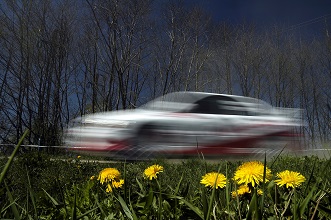Home-grown rubber to keep tyres turning

Related topics
Environment & climate action Innovation Transport Industrial Leadership Societal Challenges Advanced materials Advanced manufacturing & processing Austria Belgium Czechia France Netherlands Spain Switzerland Environment Biotechnology Nanotechnologies, advanced materials, advanced manufacturing & processing, and biotechnology Food security, sustainable agriculture and forestry, maritime and martime inland water research and bio-economy Kazakhstan United States of Americadate: 13/04/2015
Project: EU-based Production and Exploitation of ...
acronym: EU-PEARLS
See also: CORDIS -EU-PEARLS
Imports of natural rubber are essential to Europe’s manufacturers – they are used to make some 40 000 products, including car tyres, adhesives, sealants, and medical gloves. Most of this vital raw material comes from South East Asia, where it is harvested from the rubber tree.
Natural rubber is particularly critical to the health of the EU’s automotive industry, especially tyre manufacturing, which accounts for almost two-thirds of imports.
But this dependency leaves Europe’s economy vulnerable to potential shortages and price increases. Demand from emerging economies is rising. At the same time, supply is threatened by a disease affecting the rubber tree and fluctuations in production due to changing weather patterns.
In response, the EU is investing in research to encourage home-grown sources of natural rubber. It’s part of a strategy to reduce dependence on imports and maintain competitiveness.
From rubber tyres to medical gloves
EU-funded project EU-PEARLS, which ended in September 2012, has set the stage by demonstrating that natural rubber from the Russian dandelion (Taraxacum koksaghyz) and the flowering shrub guayule (Parthenium argentatum) could be harvested in Europe as a viable substitute.
Researchers obtained 800g of dry rubber from the roots of Russian dandelion grown in Germany. The plant is native to Kazakhstan. In parallel, 2kg of dry rubber was also produced from the bark and stems of guayule at a one hectare site in Spain. Guayule is found in parts of the US and Mexico.
The rubber from both crops was found to be of the same high quality as that from the rubber tree, and was tested in the treads of prototype car tyres. The tests even showed an improvement in grip, says project coordinator Hans Mooibroek of Netherlands-based Stichting Dienst Landbouwkundig Onderzoek (DLO), part of Wageningen University & Research Centre.
Hypoallergenic latex from guayule was also used to produce medical gloves. This is an important advantage as latex from the rubber tree can cause a life-threatening allergic reaction in some people. The project also:
- outlined a cost-effective, efficient and sustainable alternative rubber supply chain, including extraction, processing and application;
- developed new breeding varieties of Russian dandelion with high rubber yields and improved quality;
- identified the best lines of both crops suited for optimal growth conditions (guayule for southern Europe and Russian dandelion for the northern Europe climate);
- produced dandelion and guayule seeds for use by researchers and industry;
- analysed the economic feasibility of by-products – inulin from dandelion as a green source for chemicals and as a food additive; guayule resins for use by the chemical industry;
- provided guidance to suppliers and manufacturers on how to exploit and profit from the research.
“The research has sparked interest across industry,” says Mooibroek. “Some have made commitments to invest in the commercial development of rubber from Russian dandelion and guayule, including investments for large-scale cultivation and extraction facilities for use in tyres, medical gloves and mattresses.”
A dandelion supply chain
Using this research as a starting point, the EU-funded project DRIVE4EU has taken up the challenge of bringing rubber from the Russian dandelion closer to commercialisation. The four-year project, which ends in January 2018, is developing an initial supply chain for rubber and inulin to demonstrate its commercial potential. Afterwards, it will be up to industry to take up the challenge, says project coordinator Ingrid M. van der Meer of Stichting DLO.
“DRIVE4EU will bridge the gap between research and the market, leading to the commercialisation of the research results for the Russian dandelion,” says van der Meer.
While the project’s focus is the Russian dandelion because of its high quality rubber, DRIVE4EU is also kick-starting research into the economic potential of inulin as a by-product. Inulin could be used to produce chemicals in an environmentally friendly way and could help make the plant more economically attractive to farmers and processors.
The team’s work involves scaling up each step in the production chain – breeding, seed production, cultivation, extraction of natural rubber and inulin, and their conversion into products. Project partners in France and Germany plan to build large processing machinery to handle the expected dandelion output. One year into the project, the partners have:
- developed dandelion lines with higher rubber content and larger roots;
- produced enough seeds to begin harvesting several hectares of crop per year – with plans to develop farms in Germany, Kazakhstan, Belgium and the Netherlands;
- improved cultivation methods;
- harvested 25kgof dry root material before winter 2014 – with plans to scale up to 400kgin spring 2015, and 3 tonnes in 2016;
- performed large-scale extraction tests on both rubber and inulin;
- completed a preliminary analysis indicating that producing rubber and inulin from the plant is economically feasible.
“The economic development of Russian dandelion cultivation will make the EU less dependent on imports, serve as a response to the threat of a global rubber shortage, and could create many new jobs in Europe,” says van der Meer. “DRIVE4EU will provide the EU with a valuable business case for its development.”
Below picture of tyres - outcome of EU-PEARLS and DRIVE4EU projects
©Wageningen UR
